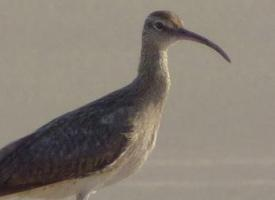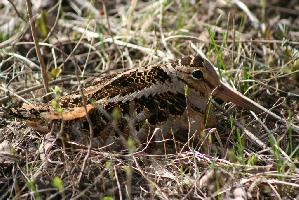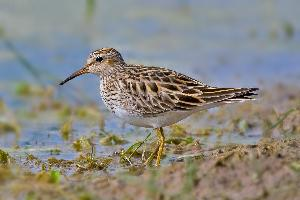
Poids et mesures
| Hauteur au garrot | de 37 à 45 cm |
|---|
Description de l'animal
The Eurasian Whimbrel, scientifically known as Numenius phaeopus, is a fascinating and widely distributed species of wader in the large family Scolopacidae, which includes sandpipers and their allies. This bird exhibits a remarkable blend of adaptability and migratory prowess, making it a subject of interest among birdwatchers and ornithologists alike.Characteristically, the Eurasian Whimbrel is a medium-sized bird, with adults typically reaching lengths of about 37 to 47 cm and boasting a wingspan that ranges from 75 to 90 cm. One of the most distinctive features of this species is its long, down-curved bill, which measures around 6 to 9 cm in length. This unique adaptation is perfectly suited for probing mud and sand for invertebrates while foraging along coastal mudflats, marshes, and beaches. The plumage of the Eurasian Whimbrel is predominantly brown, with a striped appearance on the head and neck, thanks to dark brown streaks over a lighter brown background. This cryptic coloration serves as excellent camouflage, blending seamlessly into the bird's natural habitats.
Behaviorally, the Eurasian Whimbrel is known for its impressive migratory habits. Breeding primarily in the Arctic tundra of Scandinavia, Russia, and Alaska, this species undertakes long-distance migrations to wintering grounds that stretch as far south as Australia and New Zealand in the Pacific, and to South Africa and South America in the Atlantic. During these migrations, the whimbrel is known to fly long distances over the open ocean, showcasing remarkable endurance.
The diet of the Eurasian Whimbrel is quite varied, consisting mainly of invertebrates such as crabs, mollusks, and marine worms. However, during the breeding season, when in the Arctic tundra, their diet shifts to include insects, berries, and small rodents, showcasing the bird's opportunistic feeding behavior.
The breeding behavior of the Eurasian Whimbrel is as interesting as its migratory patterns. Nests are typically simple depressions on the ground, lined with bits of plant matter and situated in open areas of the tundra. Females lay a clutch of usually four eggs, which both parents then incubate. Once hatched, the chicks are precocial, meaning they are relatively mature and mobile from the moment of birth. Both parents are involved in feeding and protecting the chicks until they fledge.
The call of the Eurasian Whimbrel is another distinctive trait, a series of clear, whistling sounds that can be heard during the breeding season and is often likened to a series of questions and answers. This vocalization plays a crucial role in social interactions and the establishment of territories during the breeding season.
Despite facing threats from habitat loss and degradation, particularly in its migratory stopover and wintering grounds, the Eurasian Whimbrel has maintained a relatively stable population, thanks in part to its vast range and adaptability. However, continued conservation efforts are necessary to ensure that this fascinating species can continue to thrive in the face of increasing environmental pressures.
Animaux similaires
Nouvelles photos d'animaux
Top 10 des animaux
- Dolphin gull (Leucophaeus scoresbii)
- Diana monkey (Cercopithecus diana)
- Moustached guenon (Cercopithecus cephus)
- Galápagos tortoise (Geochelone nigra complex)
- Stone loach (Barbatula barbatula)
- Japanese macaque (Macaca fuscata)
- Russian tortoise (Testudo horsfieldii)
- Greek tortoise (Testudo graeca)
- Common flying dragon (Draco volans)
- Vendace (Coregonus albula)


